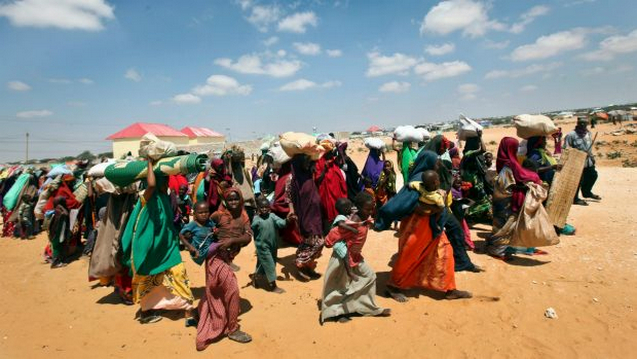World Heritage reefs will die of heat stress unless global warming is curbed, a new UN study finds.
 |
| A diver explores corals on the Great Barrier Reef off Australia, the largest living structure on Earth. PHOTOGRAPH BY DAVID DOUBILET, NATIONAL GEOGRAPHIC CREATIVE |
And consequences could be severe for millions of people.
The decline of coral reefs has been well documented, reef by reef. But the new study is the first global examination of the vulnerability of the entire planet's reef systems, and it paints an especially grim picture. Of the 29 World Heritage reef areas, at least 25 of them will experience twice-per-decade severe bleaching events by 2040—a frequency that will "rapidly kill most corals present and prevent successful reproduction necessary for recovery of corals," the United Nations Educational, Scientific and Cultural Organization concluded. In some areas, that's happening already.
 |
| An aerial view of snorkel and dive boats at Sombrero coral reef system off the Florida Keys during spring extreme low tides. PHOTOGRAPH BY MIKE THEISS, NATIONAL GEOGRAPHIC CREATIVE |
 |
| Divers swim past a reef wall teeming with fish. PHOTOGRAPH BY DAVID DOUBILET, NATIONAL GEOGRAPHIC CREATIVE |
Mass Bleachings
By 2100, most reef systems will die, unless carbon emissions are reduced. Many others will be gone even sooner. "Warming is projected to exceed the ability of reefs to survive within one to three decades for the majority of the World Heritage sites containing corals reefs," the report says.
Reefs, often referred to as the rainforests of the oceans, occupy less than one percent of the ocean floor, but provide habitat for a million species, including a fourth of the world's fish. They also protect coastlines against erosion from tropical storms and act as a barrier to sea-level rise.
 |
| Giant soft coral, likely hundreds of years old, is rooted on a coral reef wall at a depth of 40 meters in New Caledonia. PHOTOGRAPH BY ENRIC SALA, NATIONAL GEOGRAPHIC |
In the past three years, 25 reefs—which comprise three-fourths of the world's reef systems— experienced severe bleaching events in what scientists concluded was the worst-ever sequence of bleachings to date. The Great Barrier Reef was especially hard hit. Other reefs that experienced severe bleaching include the Seychelles, New Caledonia, 750 miles (1,210 kilometres) east of Australia, and the United States, off Hawaii and Florida.
"The last three years have been extremely depressing for me," Eakin, with NOAA, says. "We're seeing truly catastrophic damage to many reef systems around the world. The Great Barrier Reef damage we've seen is greater than anything we've seen in the past 20 years."
 |
Humphead wrasse and other fish swimming in a coral reef Near Lord Howe Island, New South Wales, Australia. PHOTOGRAPH BY DAVID DOUBILET, NATIONAL GEOGRAPHIC CREATIVE
|
"These are real things that real people are experiencing," Heron says. "I've met these people. They've been to my house. This is happening."
Heron also notes that despite scepticism in some corners about climate change, even the crudest of models from two decades ago predicted just the type of reef damage seen today.
"If what the models projected back then has started to come true, even with all of their issues, then we should have good faith in the science of the current projections," Heron says. "And those projections say if we don't act there will be many, many serious impacts."
 |
| Saint Joseph Atoll, a nature reserve with a marine protected area in Seychelles Islands. PHOTOGRAPH BY THOMAS PESCHAK, NATIONAL GEORGAPHIC CREATIVE |
Most World Heritage sites are managed locally to control pollutants from farm runoff or overfishing. Now, the "ubiquitous global threat" to reef systems has become so great, Eakin and Heron say, that local protections are not enough. They hope their new, bleak assessment will help the world's nations to realise that unless they move faster to reduce greenhouse gas emissions, these special places—and the people who rely on them—will suffer greatly, far sooner than expected.
"When someone needs help, the overwhelming majority of us will stretch ourselves to help out—it's a human trait. It's what makes us people," Heron adds. "That the people most impacted by these changes are not necessarily people we encounter in our day-to-day lives does not remove our responsibility to help them."
Links
- 3D-Printed Reefs Offer Hope in Coral Bleaching Crisis
- Warming Bleaches Two-Thirds of Great Barrier Reef
- Aussie Scientists Find New Reef Behind The Great Barrier Reef
- Paris Agreement's 1.5c Target 'Only Way' To Save Coral Reefs, UNESCO Says
- Great Barrier Reef 'Too Big To Fail' At $56b, Deloitte Access Economics Report Says
- Great Barrier Reef 2050 Plan No Longer Achievable Due To Climate Change, Experts Say
- Half The Great Barrier Reef May Have Died In Last Two Years
- The Impact Of Climate Change On The Great Barrier Reef
- Coral-Bleaching Database Puts Australia Second Worst In The World
- Loss Of Coral Reefs Caused By Rising Sea Temperatures Could Cost $1tn Globally
- Great Barrier Reef: Severe Coral Bleaching Hits Two-Thirds Of Reef, Aerial Surveys Show
- Australia's Politicians Have Betrayed The Great Barrier Reef And Only The People Can Save It
- Climate Change Is Killing The Great Barrier Reef
- Coral Crisis: The Great Barrier Reef Needs Us To Speak Up



